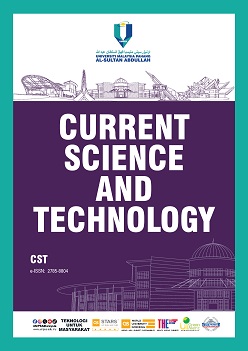Catalyst Effect on Steryl Glucosides Concentration in Palm-Based Biodiesel During Transesterification Process
DOI:
https://doi.org/10.15282/cst.v4i1.11560Keywords:
Bicatalyst, Transesterification, Steryl glucoside, CaO mixed SiO₂Abstract
In this study, biodiesel was synthesized from crude palm oil through a double-step transesterification process using a CaO-SiO₂ bi-catalyst. The catalyst was designed to serve dual purposes: facilitating the transesterification reaction and removing steryl glucosides (SGs), a critical impurity in biodiesel. The process optimization was carried out using Central Composite Design to achieve maximum fatty acid methyl ester conversion. The synthesized biodiesel was characterized for density (0.863 g/cm³), viscosity (5 mPa·s), iodine value (19.572 g/100g), acid value (0.437 mg KOH/g), and conversion efficiency (81.71%), confirming its compliance with biodiesel standards. Catalyst characterization through SEM, XRD, BET, and FTIR analyses revealed an amorphous structure, high surface area (86.81 m²/g), and functional groups suitable for SG removal and catalytic activity. UV-visible spectroscopy confirmed an SG removal efficiency of 79.15 %. This study demonstrates the effectiveness of the CaO-SiO₂ bi-catalyst in integrating biodiesel synthesis and impurity removal in a single reaction, offering a simplified and efficient approach to biodiesel production.
References
[1] M. Asif, F. Javed, M. Younas, M. A. Gillani, W. B. Zimmerman and F. Rehman, “Investigating biodiesel production from Chicken fat oil using bi-functional catalysts and microbubble mediated mass transfer,” Fuel, vol. 358, p. 130125, 2024.
[2] J. Liu, T. Lin, S. Niu, J. Zhu, Z. Yang, J. Geng, et al., “Transesterification of acidic palm oil using solid waste/CaO as a bifunctional catalyst,” Fuel, vol. 362, p. 130913, 2024.
[3] G. P. Maniam, N. Hindryawati, I. Nurfitri, R. Jose, M. H. A. Rahim, F. A. Dahalan, et al., “Decanter cake as a feedstock for biodiesel production: A first report,” Energy Conversion and Management, vol. 76, pp. 527-532, 2013.
[4] A. Montpetit and A. Y. Tremblay, “A quantitative method of analysis for sterol glycosides in biodiesel and FAME using GC‐FID,” Journal of the American Oil Chemists' Society, vol. 93, no. 4, pp. 479-487, 2016.
[5] S. B. Lee, K. H. Han, J. D. Lee and I. K. Hong, “Optimum process and energy density analysis of canola oil biodiesel synthesis,” Journal of Industrial and Engineering Chemistry, vol. 16, no. 6, pp. 1006-1010, 2010.
[6] S. M. Farouk, A. M. Tayeb, S. M. S. Abdel-Hamid and R. M. Osman, “Recent advances in transesterification for sustainable biodiesel production, challenges, and prospects: A comprehensive review,” Environmental Science and Pollution Research, vol. 31, no. 9, pp. 12722-12747, 2024.
[7] R. Kasirajan, “Biodiesel production by two step processes from an energy source of Chrysophyllum albidum oil using homogeneous catalyst,” South African Journal of Chemical Engineering, vol. 37, pp. 161-166, 2021.
Downloads
Published
Issue
Section
License
Copyright (c) 2024 The Author(s)

This work is licensed under a Creative Commons Attribution-NonCommercial 4.0 International License.



